There is no resemblance between Korea's agriculture of today and the traditional agriculture we have known. Based on state-of-the-art technology, Korea's current agriculture is playing a leading role in Korea's efforts for green growth.
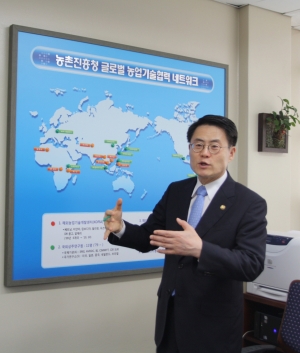
In an interview with Korea IT Times, Dr. Kim Jae-Soo, Vice Minister of Ministry for Food, Agriculture, Forestry and Fisheries, and Former Administrator of the Rural Development Administration of Korea said, "Korea's upgraded farming technology is one of the main props of the national agenda of 'low-carbon, green growth.' In other words, our agriculture has been emerging as a new growth industry that takes on climate change in a preemptive manner and takes advantage of the convergence of water resources and technology. In addition, in terms of energy conservation and alternative energy production, renewable energies like LED lights and geothermal energy are utilized to relieve farmers from the burden of heavy farm management costs. What's more, agricultural byproducts such as livestock manure are turned into resources that are used as alternative energy sources."
As Dr. Kim explained, Korea's agricultural technology has indeed made a quantum leap: LED lights are used as alternative energy to slash heating costs, and livestock waste is turned into compost and electricity. Thanks to these technological advances, Korea's agricultural production grew a remarkable 1.2-fold last year despite a more than 15,000-hectare loss of total farmland.
What's more, Korea's agriculture is also setting its eyes on the devolvement of convergence technologies that capitalize on biological resources. The Rural Development Administration of Korea plans to develop functional materials by utilizing biological resources such as insects and plants. Then, the developed functional materials will be taken to new heights with the help of convergence technologies to nurture future growth industries like biological drugs, organ development and plant factories.
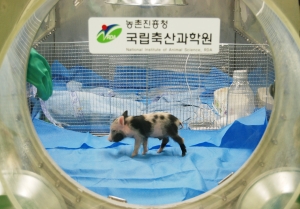
The Rural Development Administration has already developed artificial eardrums from cocoons (the first in the world), and is planning to conduct clinical demonstrations with the goal of commercializing artificial eardrums within five years and knocking on the doors of the global market (worth KRW 250 billion) at the same time. Added to that, the Administration has teamed up with Hallym University (a private university located in Chuncheon, Korea) to develop artificial bones, while the global market for this is estimated at KRW five trillion. Furthermore, studies on milk quality analyzers, raising miniature pigs geared towards organ donations and mixing the roots of plants for better plant breeding are under way in earnest.
The world's first plant factory and adoption of IT convergence technology
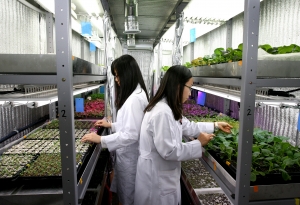
Dr. Kim mentioned, "Have you ever heard about plant factories In January of this year, the Rural Development Administration set up the world's first plant factory, shaped like a container, in King Sejong Station, located on Antarctica's King George Island. Thus, Sejong Station researchers are now raising vegetables by themselves at -40°C. This plant factory is easily movable, so it enables vegetable cultivation anywhere, anytime - for instance, the Polar Regions and the middle of desserts and oceans.
He continued, "As I said before, plant factories have received a lot of attention in that they make horticulture possible regardless of location and weather conditions (climate change) and help us fundamentally tackle food shortages brought on by global warming, population growth and decreasing farmlands while enabling farming under any circumstances. In particular, plant factories can serve their purposes in the Middle East like oil-rich Dubai, dessert areas, the Polar Regions, deep-sea fishing vessels and deep-sea oil rigs, so exports of plant factories and entry into oversea markets are the expected outcome of this plant factory project."
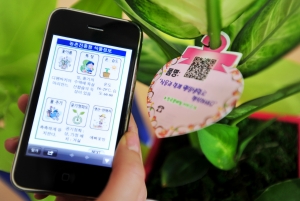
The Rural Development Administration has developed an IT convergence system called QR (Quick Response) that transmits information --such as the names and characteristics of plants, watering cycles and air purification-- via smartphones. As a matter of fact, formal botanical names for plants are not translated into Korean, so even plant experts find it hard to have a good grip on all the names and species. By simply connecting OR to smartphones, farmers can obtain all the information on plants they need. Agricultural products, grown under automated systems like the above-mentioned eco-friendly plant management information system, are selling on the market at the moment.
The seed industry's endeavor for developing new seeds is worth attention, too. As of now, the Korean seed market is worth US$580 million or 1.6% of the global seeds market. Korea's seed market is led by both the public and private sectors: the Korean government develops and distributes food crops, while the private sector takes responsibility for developing and distributing commercial crops like vegetables, fruits and grass. Korea's agricultural export portfolios mainly consist of vegetables and flowers including radishes, cabbages, red peppers and chrysanthemums, rather than rice and barley that have to compete against their counterparts produced by agricultural powerhouses like the United States. Their major export destinations are China, Japan and the Netherlands. New export items such as watermelons, oriental melons and tomatoes are being exported to Russia and European nations. Although Korea's agricultural exports are small in volume as of right now, the country aims to inflate its export volume and expedite exports of plants (plant factories).
Studies to minimize the damage from climate change
For the past century, the average global temperature has risen 0.75 degrees, while Korea has seen a bump in the form of a 1.5-degree increase in average temperature. According to experts, a one degree rise in temperature results in the agro-climatic northern limit lines for safe cultivation to move up by 81 km and the altitude to rise by 154 km. Likewise, global warming has also been responsible for Korea's farmland moving north: Hanlabong (Korean Orange)and kiwis, which used to be raised on Jeju Island (Korea's southern-most island), are now being cultivated in Geoje, Gyeongsangnam-do (a province in the southeast of Korea); green tea is now raised in Goseong (a county in Gangwon Province), but was previously raised in Boseong County (a county in South Jeolla Province); and apples and peaches are now in Yeongwol County (a county in Gangwon Province) which were previously raised in Daegu.
The Rural Development Administration is also conducting various studies to minimize the damage from climate change. Studies are underway to assess the climate damage vulnerability of 21 farming belts on the Korean peninsula, and to explore ways to defend these vulnerable farming belts against climate disasters. In addition, the Administration takes part in APEC international workshops on international cooperation for the prevention of blight and insect outbreaks.
"Have you ever heard about rice stripe disease Rice stripe disease is caused by small brown plant hoppers carrying the rice stripe virus (RSV), a plant pathogenic virus. Plants infected with rice stripe virus (RSV) dry up until death. Once plants are infected by the disease, pest control is of no use. To tackle this issue, we have studied the travel routes of rice stripe virus (RSV) from China and South East Asian nations to Korea, and undertaken a project called "Development of Technology aimed at Preventing and Monitoring Rice Stripe Disease Outbreaks". Through the project, we aim to constantly monitor and make predictions on possible outbreaks of rice stripe disease, and to nip them in the bud. Furthermore, studies on harmful insects and viruses including ussur brown katydids, bacterial leaf blight (BLB) of rice and lycorma delicatula are being conducted in an active manner," said Dr. Kim.
Globalization of advanced agricultural technologies
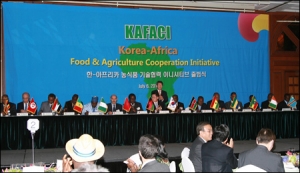
Dr. Kim said, "The Rural Development Administration of Korea set up the Asian Food and Agriculture Cooperation Initiative (AFACI) last year to introduce Korea's customized agricultural technology to develop nations in Asia such as Vietnam, Myanmar and Cambodia. Moreover, on July 6th , we launched KAFACI (Korea-Africa Food and Agriculture Cooperation Initiative) to teach African nations Korea' advanced farming technologies. Through KAFACI , nearly 3,200 Korean technicians will be dispatched to 16 African nations including Nigeria, Angola, Cameron and Congo in order to hand down our advanced farming technologies. The importance of delivering customized agricultural technologies to developing nations is to teach local people how to grow agricultural products on their own soil, not to simply distribute food to the poor. In other words, we teach them how to catch fish rather than giving fish.
The Rural Development Administration set up KOPIA (Korea Project on International Agriculture) centers in countries including Vietnam, Kenya, Brazil, Uzbekistan and Myanmar to spread Korea's customized agricultural technology. Also, the Administration invited 3,464 foreigners from 116 nations and trained 499 trainees in seven nations.
Dr. Kim added, "A young Korean farmer who was dispatched to Africa has drawn a lot of attention from local people in Kenya for transforming a bicycle into a thrashing machine. This year alone, 120 young leaders are scheduled to go to KOPIA centers in Kenya. Therefore, I expect they will get the same favorable reception from local people for making such breakthroughs.
KOPIA centers in Kenya have built and are operating vinyl greenhouses, poultry farms and distributed agricultural machines such as bicycle-turned thrashers and rice planting machines in order to help the region's farming stand on its own. The Rural Development Administration's contributions to the international community -- namely playing a leading role in lifting Africa and many other developing nations out of poverty and facilitating economic development- seem to translate into an improvement in Korea's national brand image.
Still, when it comes to Korea's agriculture, most of the Koreans conjure up images of the traditional agriculture of 50 to 60 years ago. In the past, we used to use the word "Gui-nong (returning to the soil)". It is now inappropriate to use the word in that sense. Right now, 10 percent of cutting-edge technologies cultivate 90 percent of the agricultural products in Korea, and there is hope that Korea's advanced agricultural technology contributes to taking the global farming industry to a new level.


